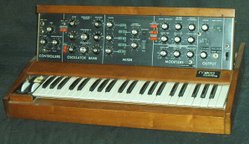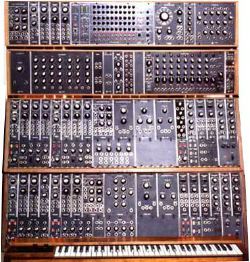 Mini Moog
Mini Moog |
Weapon
of Choice:
Moog |
 Moog Modular
Moog Modular |
The term Moog (pronounced /mo?g/ to rhyme with "vogue",
not /mu?g/) synthesizer can refer to any number of analog synthesizers
designed by Dr. Robert Moog or manufactured by Moog Music, and is
commonly used as a generic term for analog and digital music synthesizers.
Moog synthesizers
Moog synthesizers were one of the first widely used electronic musical
instruments. Robert Moog created the first subtractive synthesizer
to utilize a keyboard as a controller in 1964 and demonstrated it
at the AES convention. It sometimes took hours to set up the machine
for a new sound.
Robert Moog employed his theremin company (R. A. Moog Co., which
would later become Moog Music) to manufacture and market his synthesizers.
They were shipped with an organ-style keyboard as the standard user
interface. The Moog was not necessarily considered a performance
instrument, but rather a sophisticated, studio-oriented professional
audio system which could be used as a musical instrument; the keyboard
was simply a convenient and familiar way to control it. Particularly
because of the pitch instability of its oscillators as well as the
atonal nature of electronic music of the time, the original Moog
synthesizer was designed for creating recorded electronic music.
Later modular Moogs would have much-improved oscillators and were
better suited to real-time musical performance.
The first Moog instruments were modular synthesizers. In 1971 Moog
Music began production of the Minimoog Model D
which was among the first widely available, portable and relatively
affordable synthesizers. Unlike the modular synthesizer, the Minimoog
was specifically designed as a self-contained musical instrument
for keyboard players (besides the extremely user-friendly physical
design, it also stayed in tune reasonably well) and was the first
to really solidify the synthesizer's popular image as a "keyboard"
instrument. The Minimoog became the most popular monophonic
synthesizer of the 1970s, selling approximately 13,000
units between 1971 and 1982.
Another widely used and extremely popular Moog synthesizer was the
Taurus bass pedal synthesizer. Released in 1975, its pedals were
similar in design to organ pedals and triggered synthetic bass sounds.
The Taurus was known for a "fat" bass sound and was used
by bands such as Genesis, Rush, U2, Yes, The Police, Pink Floyd
and many others. Production of the original was discontinued in
1981, when it was replaced by the Taurus II.
Moog Music was the first company to commercially release a keytar,
the Moog Liberation.
The last Moog synthesizers were manufactured in 1985 before the
original Moog Music declared bankruptcy in 1986. In 2001, Robert
Moog's company Big Briar was able to acquire the rights to the Moog
name and officially became Moog Music. (See Moog Music.) Moog Music
has been producing the Minimoog Voyager, modeled after the original
Minimoog, since 2002.
In March of 2006, Moog Music unveiled the Little Phatty Analog Synthesizer,
boasting "hand-built quality and that unmatched Moog sound,
at a price every musician can afford". The first limited edition
run of 1200 will be a Bob Moog Tribute Edition with a Performer
edition soon to be announced.
Moog synthesizers in culture
According to the American Physical Society, "The first live
performance of a music synthesizer was made by pianist Paul Bley
at Lincoln Center in New York City on December 26, 1969. Bley developed
a proprietary interface that allowed real time performance on the
music synthesizer."
It is believed that the first phonograph record to feature a Moog
synthesizer was Cosmic Sounds by The Zodiac. The first popular music
album to feature the instrument was 1967's Pisces, Aquarius, Capricorn,
& Jones, Ltd. by The Monkees. Wendy Carlos
(formerly Walter Carlos) released major Moog albums in 1968 and
1969: Switched-On Bach and The Well-Tempered Synthesizer.
The former earned Carlos three Grammys. Also in 1969, The Beatles
used a Moog throughout the Abbey Road album. It was also featured
prominently on Emerson, Lake & Palmer's song
"Lucky Man," Keith Emerson's Moog solo at the end making
it arguably the group's most popular piece. Another famous use of
the Moog was in Tangerine Dream's electronic landmark
album Phaedra in 1974. Glenn Tilbrook, a member of the new wave
band Squeeze, was also known to use the Mini Moog with regularity.
The success of Carlos' Switched-On Bach sparked
a series of other synthesizer records in the late 1960s to mid 1970s.
These albums featured covers of songs arranged for Moog synthesizer
in the most dramatic and flamboyant way possible, covering rock,
country and other genres of music. The albums often had "Moog"
in their titles (i.e. Country Moog Classics, Martin Denny's Exotic
Moog, etc.) although many used a variety of other brands of synthesizers
and even organs as well. The kitsch appeal of these albums continue
to have a small fanbase and the 1990s band Moog Cookbook
is a tribute to this style of music.
One well known use of the synthesizer was in the 1971 movie A
Clockwork Orange, in which Carlos wrote all the original
music for the Moog, along with several Moog versions of classical
music, creating a very eerie mood that was considered very successful
at expressing the strange society of the movie.
A popular Moog user (and programmer) is Stevie Wonder
who won numerous Grammy awards in 1973 for his synthesizer rich
Talking Book and also in 1974 where he grabbed
the 'Album of the Year' award with yet another Moog-tinted album
Innervisions.
Ronnie Martin of Joy Electric is a musician who continues to use
only the moog to record his interesting brand of electronic music.
Popularity surged in the 1970s, then declined in the 1980s as digital
synthesizers gained traction in the market. By the mid-1990s, analog
synthesizers were again highly sought after and prized for their
classic sound. As of 2004, more than 15 companies are making Moog-style
synthesizer modules. -- courtesy of wikipedia
Visit the official Moog Music web site: moogmusic.com
|
